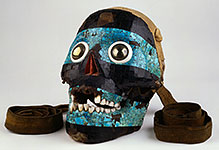
Native American Religions
Religions and cults of the indigenous people of the American continent: North American tribes, Aztec, Maya, and other natives.

#120102 8
Trunk-like noses of the rain-god Chac form the cornice of the East Buil...

#12010232
The Look-out, an upper temple with typical Puuc- style crest, on top of a...

#12010233
Lower section of a small building in front of the Look-out, a temple with...

#12010237
The Palace of the Large Masks, Kabah, Puuc Archaeological Zone, Yuc...

#12010247
Stairs of the Nohoch Mool Pyramid at Coba, Yucatan. Coba was once a city of...

#12010249
Tulum, on a high cliff above the Caribbean Sea, was the last ceremonial...

#12010250
The Maya ceremonial center and town of Tulum was built on a high cliff ab...

#12010251
The so-called Castle, the pyramid of the Tulum ceremonial center, and t...

#12010256
The Temple of the Frescoes, Tulum, Yucatan. Portico with four sturdy columns...

#12010262
Xcaret, a small ceremonial center near Tulum. The pyramid (7th-10th CE...

#12010263
Temples in Xcaret, a small ceremonial center and settlement near Tulu...

#12010264
Teotihuacan, "Place of the Gods" was the most important ceremonial center in Mes...